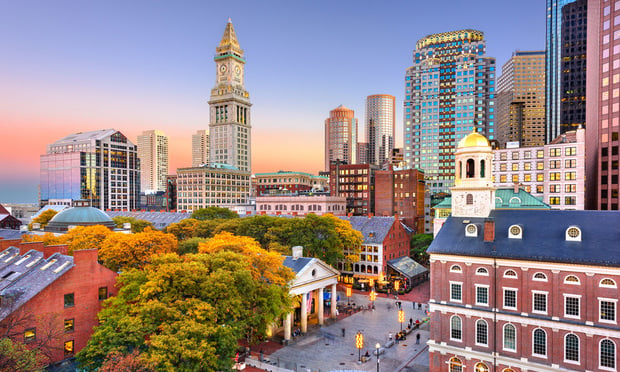BOSTON—Impressive job growth and the attraction of Millennials to the downtown core continue to fuel multifamily development in Boston.
Brokerage firm Marcus & Millichap projects that employers in the Boston metro will add 60,000 jobs in 2016, a 2.3% expansion from 2015 when the workforce increased by nearly 58,000 positions.
The report also notes, “Rampant hiring by technology and science firms supported the 0.9% increase in the prime renter cohort of 20 to 34 year olds. These higher wage residents are generating demand for well-located units, while other sectors seek out affordability and access to rail and highways.”
Tim Thompson, regional manager of Marcus & Millichap's Boston office, says that strong hiring has advanced household formation by 12,200 during the pat 12 months and the Boston metro population has increased by nearly 30,000 residents in the past year, a 0.6% population increase.
In 2016, Marcus & Millichap expects builders will add 6,500 units to the Greater Boston housing stock, down slightly from the 6,900 units added in 2015. Despite the heady development pipeline, the market for both luxury/market rate rental housing, as well as affordable units, has absorbed all of the available units. The multifamily vacancy rate is expected to remain flat at just 2.8% at year's-end.
Meanwhile, apartment rents will increase for the seventh consecutive year in 2016, rising 5.9% to $1,965 a month in Greater Boston. However, that price is a bit misleading since apartments at properties in Downtown Boston command anywhere from $4,000 to $7,000 a month. Last year, rents in Greater Boston increased 5.8%.
In terms of the multifamily pipeline, there are 12,000 units under construction that are expected to be delivered through the third quarter of 2018. Thompson says the majority of the projects in development are market rate properties, while there are a handful of projects earmarked as affordable and senior living residents (aged 55 and over). He adds that there are several new condominium developments and rumors are circulating in real estate circles that a number of property owners are exploring converting their proposed rental apartment projects to condominium.
He says that the strong job growth, particularly for new high-paying positions may be prompting developers to at least consider condo instead of rental. Thompson notes that the normal high-paying sectors such as professional and business services, construction, education and health services accounted for 65% of the new jobs created in Boston over the last 12 months.
“The shift to condos may not necessarily be out of the fear for renting apartments (due to competition from numerous other projects in development) but just that our demographic seems to be shifting at least if you look at the employment statistics, to employment in higher paying jobs,” Thompson says.
Marcus & Millichap expects the investment market to remain strong, with Class A assets selling at record prices, while the firm predicts high net worth individuals will target Class B and C properties as rent hikes continue.
“Premium assets in the core and parts of Cambridge can trade at cap rates between 3% and 4%, with higher yields up to 6% generated by properties in better asset classes in areas outside the core,” the brokerage firm states in the report. “Investor demand shows no signs of slowing as sales velocity continues to overshadow prior high levels.”
When asked if he sees the Boston multifamily market continuing its strong performance going forward, Thompson responds, “Based on the demand we are seeing, we are extremely optimistic about the Boston market and the fundamentals support everything that is going on here in Boston.”
BOSTON—Impressive job growth and the attraction of Millennials to the downtown core continue to fuel multifamily development in Boston.
Brokerage firm Marcus & Millichap projects that employers in the Boston metro will add 60,000 jobs in 2016, a 2.3% expansion from 2015 when the workforce increased by nearly 58,000 positions.
The report also notes, “Rampant hiring by technology and science firms supported the 0.9% increase in the prime renter cohort of 20 to 34 year olds. These higher wage residents are generating demand for well-located units, while other sectors seek out affordability and access to rail and highways.”
Tim Thompson, regional manager of Marcus & Millichap's Boston office, says that strong hiring has advanced household formation by 12,200 during the pat 12 months and the Boston metro population has increased by nearly 30,000 residents in the past year, a 0.6% population increase.
In 2016, Marcus & Millichap expects builders will add 6,500 units to the Greater Boston housing stock, down slightly from the 6,900 units added in 2015. Despite the heady development pipeline, the market for both luxury/market rate rental housing, as well as affordable units, has absorbed all of the available units. The multifamily vacancy rate is expected to remain flat at just 2.8% at year's-end.
Meanwhile, apartment rents will increase for the seventh consecutive year in 2016, rising 5.9% to $1,965 a month in Greater Boston. However, that price is a bit misleading since apartments at properties in Downtown Boston command anywhere from $4,000 to $7,000 a month. Last year, rents in Greater Boston increased 5.8%.
In terms of the multifamily pipeline, there are 12,000 units under construction that are expected to be delivered through the third quarter of 2018. Thompson says the majority of the projects in development are market rate properties, while there are a handful of projects earmarked as affordable and senior living residents (aged 55 and over). He adds that there are several new condominium developments and rumors are circulating in real estate circles that a number of property owners are exploring converting their proposed rental apartment projects to condominium.
He says that the strong job growth, particularly for new high-paying positions may be prompting developers to at least consider condo instead of rental. Thompson notes that the normal high-paying sectors such as professional and business services, construction, education and health services accounted for 65% of the new jobs created in Boston over the last 12 months.
“The shift to condos may not necessarily be out of the fear for renting apartments (due to competition from numerous other projects in development) but just that our demographic seems to be shifting at least if you look at the employment statistics, to employment in higher paying jobs,” Thompson says.
Marcus & Millichap expects the investment market to remain strong, with Class A assets selling at record prices, while the firm predicts high net worth individuals will target Class B and C properties as rent hikes continue.
“Premium assets in the core and parts of Cambridge can trade at cap rates between 3% and 4%, with higher yields up to 6% generated by properties in better asset classes in areas outside the core,” the brokerage firm states in the report. “Investor demand shows no signs of slowing as sales velocity continues to overshadow prior high levels.”
When asked if he sees the Boston multifamily market continuing its strong performance going forward, Thompson responds, “Based on the demand we are seeing, we are extremely optimistic about the Boston market and the fundamentals support everything that is going on here in Boston.”
Want to continue reading?
Become a Free ALM Digital Reader.
Once you are an ALM Digital Member, you’ll receive:
- Breaking commercial real estate news and analysis, on-site and via our newsletters and custom alerts
- Educational webcasts, white papers, and ebooks from industry thought leaders
- Critical coverage of the property casualty insurance and financial advisory markets on our other ALM sites, PropertyCasualty360 and ThinkAdvisor
Already have an account? Sign In Now
*May exclude premium content© 2024 ALM Global, LLC, All Rights Reserved. Request academic re-use from www.copyright.com. All other uses, submit a request to [email protected]. For more information visit Asset & Logo Licensing.









